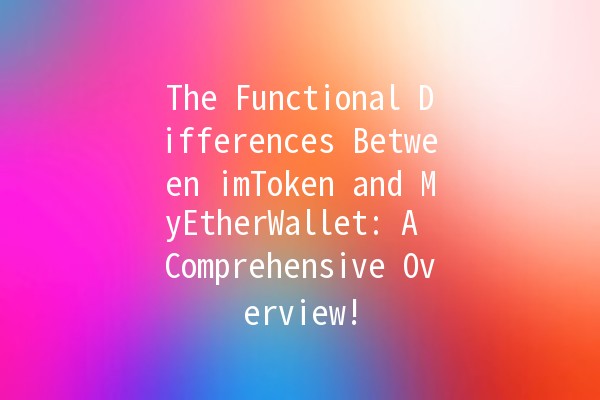When navigating the world of cryptocurrency, particularly Ethereum, two names often surface: imToken and MyEtherWallet. Both serve as essential tools for managing Ethereum and its tokens, but they have distinct functionalities, user experiences, and advantages. In this article, we will explore the key differences between imToken and MyEtherWallet, providing you with insights that can help you decide which platform best suits your needs.
Understanding the differences between imToken and MyEtherWallet can enhance your cryptocurrency management strategy. Both platforms cater to the needs of crypto enthusiasts, but they offer unique features that could influence your user experience and asset security.
ImToken is primarily a mobile wallet designed for Ethereum and other ERC20 tokens, focusing on user convenience. It provides services beyond just wallet functions, including a decentralized exchange and dApp browser, making it a versatile tool for the crypto community.

MyEtherWallet (MEW) is a webbased wallet that provides users with complete control over their Ethereum private keys. Known for its simplicity and security features, MEW allows users to manage their Ether and ERC20 tokens efficiently.
imToken operates primarily as a mobile wallet, while MyEtherWallet is predominantly webbased. This fundamental difference affects how users interact with each platform.
ImToken users can easily perform transactions onthego using their smartphones, making it convenient for everyday transactions.
MEW users may prefer using a secure desktop environment when managing their wallets, especially when handling larger amounts of cryptocurrency.
Both platforms offer a different user experience due to their interfaces and functionalities.
ImToken is designed for mobile use, providing a streamlined, intuitive experience with an aesthetically pleasing layout.
MyEtherWallet focuses on providing detailed transaction information and control, which may appeal more to users who prefer a desktop experience.
Security measures vary between imToken and MyEtherWallet, impacting how users manage their assets.
ImToken offers biometric authentication, which simplifies access while enhancing security.
MyEtherWallet, on the other hand, emphasizes the importance of users maintaining their private keys and offers integration with hardware wallets for secure key management.
ImToken includes a builtin dApp browser, while MyEtherWallet provides a more traditional wallet experience without direct dApp integration.
ImToken's ability to access dApps directly from the wallet simplifies interactions with those applications for users looking to engage with Ethereumbased services.
MEW users can still access dApps but must do so through separate interfaces or wallets, adding steps to the process.
Both platforms support the management of ERC20 tokens, but they do so in different ways.
ImToken allows users to easily manage a wide variety of tokens within a single interface.
MyEtherWallet also supports token management but requires users to manually add tokens that aren’t automatically detected.
When using either imToken or MyEtherWallet, consider the following productivityenhancing tips to optimize your experience:
Ensuring you have an additional layer of security is crucial. While imToken supports biometric options, consider adding 2FA where possible on MEW for heightened protection.
If you choose imToken, explore its dApp features fully. Try decentralized exchanges and other applications to enhance your crypto management activities.
Regularly back up your wallet on both platforms, using mnemonic phrases or private keys, to avoid loss of access.
Both platforms allow you to customize gas fees, so stay informed about Ethereum gas trends and set appropriate fees to optimize transaction costs.
Regularly educate yourself on the latest security practices in the crypto space, ensuring you are aware of potential threats and how to mitigate them.
ImToken is primarily a mobile wallet that integrates dApp browsing, offering convenience for users onthego. Conversely, MyEtherWallet is a webbased wallet focused on security and user control over private keys, making it more suitable for desktop usage.
Both wallets have their security measures. ImToken uses biometric authentication for mobile devices, while MyEtherWallet allows users to maintain full control of private keys and supports hardware wallets. Your choice may depend on your usage preferences.
Yes, many users leverage both wallets for different purposes. Using imToken for daily transactions while utilizing MyEtherWallet for larger holdings and managing ERC20 tokens can be an effective strategy.
Both wallets have different fee structures. Transactions on both platforms require Ethereum gas fees, while imToken may charge fees for its services, which are typically lower when using the wallet's builtin exchange functions.
If you forget your mnemonic phrase for either wallet, recovery can be impossible. It emphasizes the importance of securely storing the recovery phrase in a safe location.
ImToken offers a customer service channel through their app, while MyEtherWallet has a comprehensive knowledge base and user community support through forums.
Understanding the functional differences between imToken and MyEtherWallet is crucial for any crypto enthusiast looking to optimize their Ethereum management strategy. Whether you prioritize convenience, control, or security, both platforms have unique advantages that cater to a variety of users.
In the evolving landscape of cryptocurrency management, keeping updated with the latest features and best practices from both wallets will help you maximize your engagement with the Ethereum ecosystem. Embrace the features suited to your needs, and ensure your assets are secure while enjoying the benefits that these platforms bring.